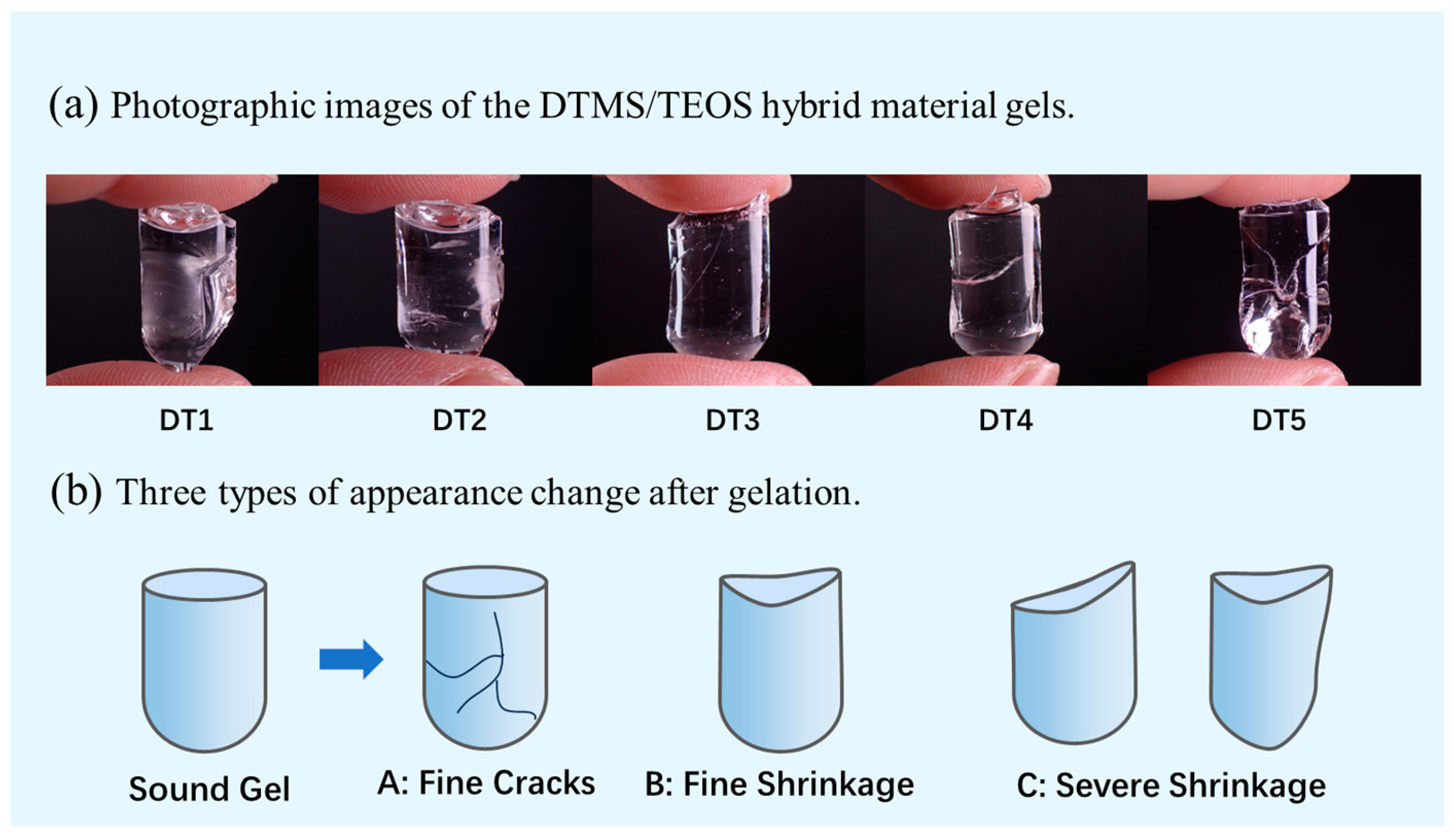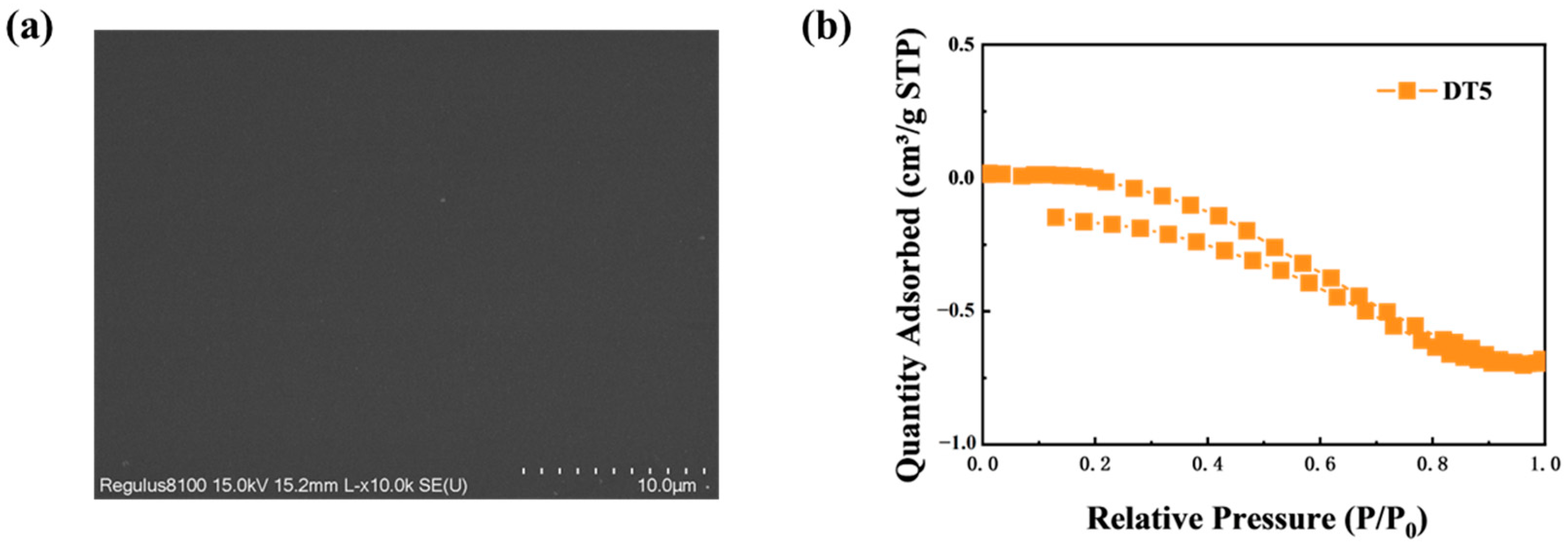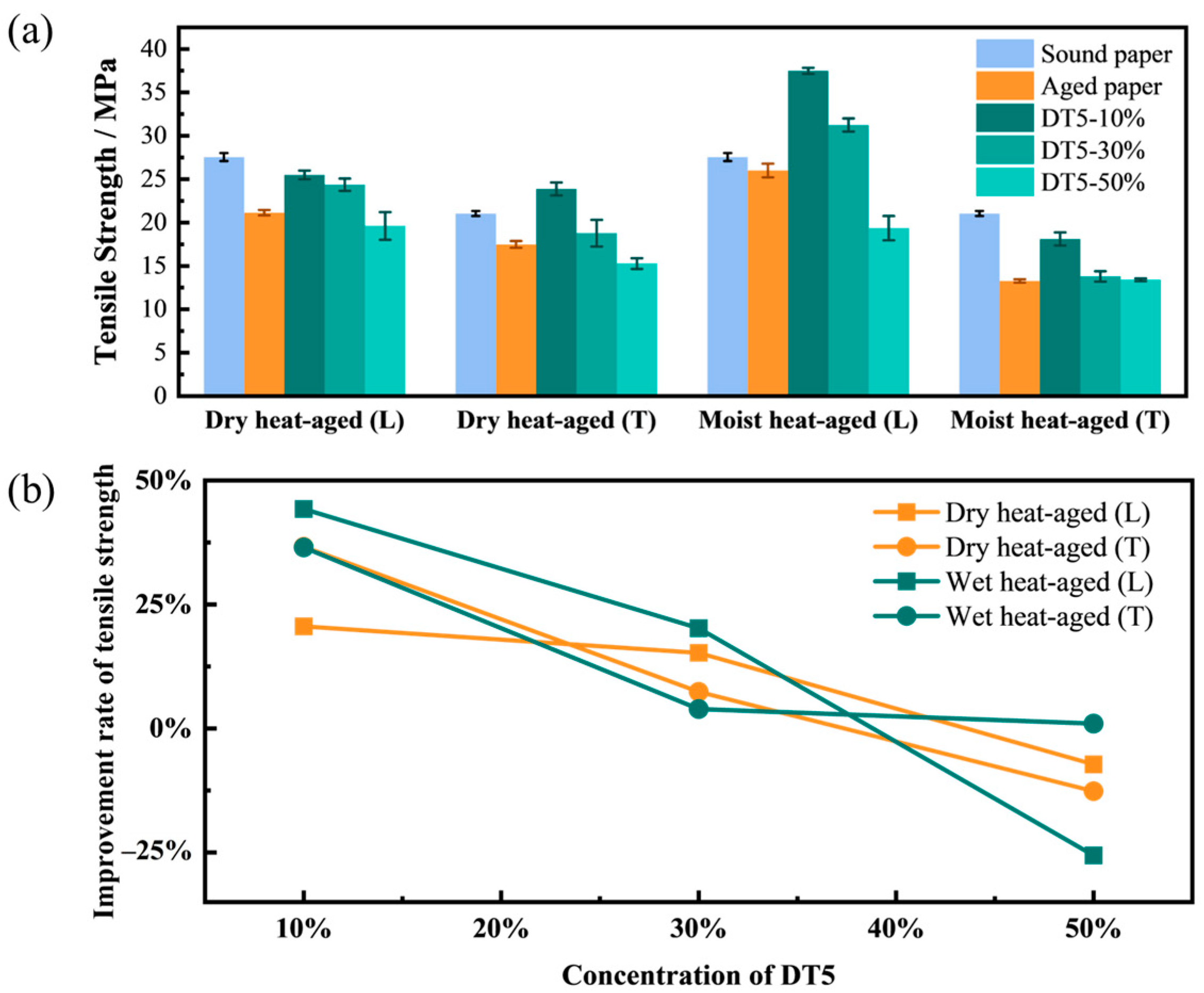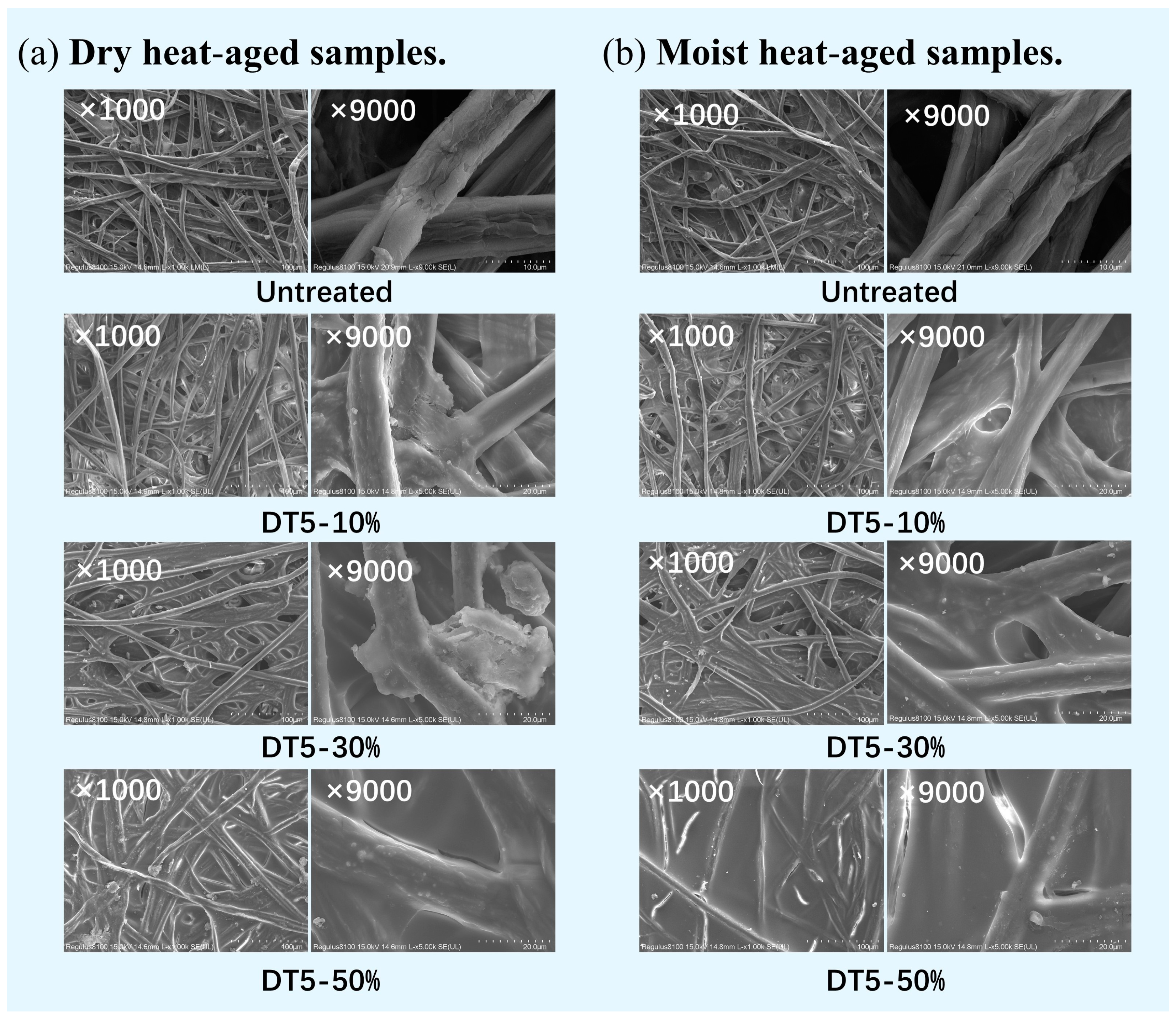Anti-Cracking TEOS-Based Hybrid Materials as Reinforcement Agents for Paper Relics
Abstract
1. Introduction
2. Results and Discussion
2.1. DTMS/TEOS Hybrid Material
2.1.1. Curing Performance
2.1.2. Thermal Stability
2.1.3. Micromorphology and Porosity
2.2. Effectiveness of DTMS/TEOS Hybrid Materials for the Reinforcement of Aged Bamboo Paper
2.2.1. Appearance and Surface Hydrophobicity
2.2.2. Tensile Strength
2.2.3. Microstructure
2.2.4. Water Vapor Transmission Rate
3. Materials and Methods
3.1. Preparation of the Hybrid Materials
3.2. Paper Aging
3.3. Reinforcement of Paper Samples
3.4. Specific Surface Area and Porosity
3.5. Glass Transition Temperature
3.6. Color Difference
3.7. Contact Angle
3.8. Tensile Test
3.9. Microstructure
3.10. Water Vapor Transmission Test
4. Conclusions
Author Contributions
Funding
Institutional Review Board Statement
Informed Consent Statement
Data Availability Statement
Acknowledgments
Conflicts of Interest
References
- Ipert, S.; Dupont, A.L.; Lavédrine, B.; Bégin, P.; Rousset, E.; Cheradame, H. Mass deacidification of papers and books. IV—A study of papers treated with aminoalkylalkoxysilanes and their resistance to ageing. Polym. Degrad. Stab. 2023, 91, 3448–3455. [Google Scholar] [CrossRef]
- Xu, Y.; Yin, H.; Yuan, S.; Chen, Z. Film morphology and orientation of amino silicone adsorbed onto cellulose substrate. Appl. Surf. Sci. 2009, 255, 8435–8442. [Google Scholar] [CrossRef]
- He, W.; Zhang, Z.; Zheng, Y.; Qiao, S.; Xie, Y.; Sun, Y.; Qiao, K.; Feng, Z.; Wang, X.; Wang, J. Preparation of aminoalkyl-grafted bacterial cellulose membranes with improved antimicrobial properties for biomedical applications. J. Biomed. Mater. Res. Part A 2020, 108, 1086–1098. [Google Scholar] [CrossRef] [PubMed]
- Xie, Y.; Hill, C.A.S.; Xiao, Z.; Holger, M.; Carsten, M. Silane coupling agents used for natural fiber/polymer composites: A review. Compos. Part A Appl. Sci. Manuf. 2010, 41, 806–819. [Google Scholar] [CrossRef]
- Gentle, T.E.; Schmidt, R.G.; Naasz, B.M.; Gellman, A.J.; Gentle, T.M. Organofunctional silanes as adhesion promoters: Direct characterization of the polymer/silane interphase. J. Adhes. Sci. Technol. 1992, 6, 307–316. [Google Scholar] [CrossRef]
- Peter, G.P.; Edwin, P.P. Methods for improving the performance of silane coupling agents. J. Adhes. Sci. Technol. 1991, 5, 831–842. [Google Scholar] [CrossRef]
- Yilgör, E.; Yilgör, I. Silicone containing copolymers: Synthesis, properties and applications. Prog. Polym. Sci. 2014, 39, 1165–1195. [Google Scholar] [CrossRef]
- Abdelmouleh, M.; Boufi, S.; Belgacem, M.N.; Duarte, A.P.; Salah, A.B.; Gandini, A. Modification of cellulosic fibres with functionalised silanes: Development of surface properties. Int. J. Adhes. 2004, 24, 43–54. [Google Scholar] [CrossRef]
- Oh, M.; Lee, S.; Paik, K. Preparation of hydrophobic self-assembled monolayers on paper surface with silanes. J. Ind. Eng. Chem. 2011, 17, 149–153. [Google Scholar] [CrossRef]
- Nowak, T.; Mazela, B.; Olejnik, K.; Peplińska, B.; Perdoch, W. Starch-Silane Structure and Its Influence on the Hydrophobic Properties of Paper. Molecules 2022, 27, 3136. [Google Scholar] [CrossRef]
- Koga, H.; Kitaoka, T.; Isogai, A. Chemically-Modified Cellulose Paper as a Microstructured Catalytic Reactor. Molecules 2015, 20, 1495–1508. [Google Scholar] [CrossRef] [PubMed]
- Carla, G.; Ana, P.C.; Mario, N.; Manuel, J.S.S.; Mohamed, N.B. Grafting of paper by silane coupling agents using cold-plasma discharges. Plasma Process. Polym. 2008, 5, 444–452. [Google Scholar] [CrossRef]
- Mahin, H.H.; Omid, R.; Habib, B. Silane–based modified papers and their extractive phase roles in a microfluidic platform. Anal. Chim. Acta 2020, 1128, 31–41. [Google Scholar] [CrossRef]
- Chen, K.; Yang, Y.; Li, P.; Zhan, Y. Study on the Strengthening of Paper Relics by Aminoalkylalkoxysilane. Guangdong Chem. Ind. 2017, 44, 11–13+22. (In Chinese) [Google Scholar]
- Shen, Y.; Li, Z.; Hou, A.; Chen, K.; Zhan, Y. Study on Reinforcement and Deacidification of Xuan Paper by Aminoalkylalkoxysilane Coupling Agents. China Pulp Pap. 2018, 37, 45–48. (In Chinese) [Google Scholar]
- Dupont, A.L.; Lavédrine, B.; Cheradame, H. Mass deacidification and reinforcement of papers and books VI—Study of aminopropylmethyldiethoxysilane treated papers. Polym. Degrad. Stab. 2010, 95, 2300–2308. [Google Scholar] [CrossRef][Green Version]
- Souguir, Z.; Dupont, A.L.; d’Espinose de Lacaillerie, J.B.; Lavedrine, B.; Cheradame, H. Chemical and physicochemical investigation of an aminoalkylalkoxysilane as strengthening agent for cellulosic materials. Biomacromolecules 2011, 12, 2082–2091. [Google Scholar] [CrossRef][Green Version]
- Souguir, Z.; Dupont, A.L.; Fatyeyeva, K.; Mortha, G.; Cheradame, H.; Ipert, S.; Lavédrine, B. Strengthening of degraded cellulosic material using a diamine alkylalkoxysilane. RSC Adv. 2012, 2, 7470–7478. [Google Scholar] [CrossRef]
- Piovesan, C.; Dupont, A.L.; Fabre-Francke, I.; Fichet, O.; Lavédrine, B.; Chéradame, H. Paper strengthening by polyaminoalkylalkoxysilane copolymer networks applied by spray or immersion: A model study. Cellulose 2014, 21, 705–715. [Google Scholar] [CrossRef]
- Piovesan, C.; Fabre-Francke, I.; Paris-Lacombe, S.; Dupont, A.L.; Fichet, O. Strengthening naturally and artificially aged paper using polyaminoalkylalkoxysilane copolymer networks. Cellulose 2018, 25, 6071–6082. [Google Scholar] [CrossRef]
- Natali, I.; Tomasin, P.; Becherini, F.; Bernardi, A.; Ciantelli, C.; Favaro, M.; Favoni, O.; Pérez, V.J.F.; Olteanu, I.D.; Sanchez, M.D.R.; et al. Innovative consolidating products for stone materials: Field exposure tests as a valid approach for assessing durability. Herit. Sci. 2015, 3, 6. [Google Scholar] [CrossRef]
- Luo, H.; Liu, R.; Huang, X. Progress in Research of Crack-Free Organosilane Consolidants for Stone Conservation. Mater. China 2012, 31, 1–8. (In Chinese) [Google Scholar]
- Maravelaki-Kalaitzaki, P.; Kallithrakas-Kontos, N.; Korakaki, D.; Agioutantis, Z.; Maurigiannakis, S. Evaluation of silicon-based strengthening agents on porous limestones. Prog. Org. Coat. 2006, 57, 140–148. [Google Scholar] [CrossRef]
- Zárraga, R.; Cervantes, J.; Salazar-Hernandez, C.; Wheeler, G. Effect of the addition of hydroxyl-terminated polydimethylsiloxane to TEOS-based stone consolidants. J. Cult. Herit. 2010, 11, 138–144. [Google Scholar] [CrossRef]
- Mosquera, M.J.; de los Santos, D.M.; Rivas, T. Surfactant-synthesized ormosils with application to stone restoration. Langmuir 2010, 26, 6737–6745. [Google Scholar] [CrossRef] [PubMed]
- Luo, Y.; Xiao, L.; Zhang, X. Characterization of TEOS/PDMS/HA nanocomposites for application as consolidant/hydrophobic products on sandstones. J. Cult. Herit. 2015, 16, 470–478. [Google Scholar] [CrossRef]
- Miliani, C.; Velo-Simpson, M.L.; Scherer, G.W. Particle-modified consolidants: A study on the effect of particles on sol-gel properties and consolidation effectiveness. J. Cult. Herit. 2007, 8, 1–6. [Google Scholar] [CrossRef]
- Liu, R.; Han, X.; Huang, X.; Li, W.; Luo, H. Preparation of three-component TEOS-based composites for stone conservation by sol-gel process. J. Sol-Gel Sci. Technol. 2013, 68, 19–30. [Google Scholar] [CrossRef]
- Xu, F.; Zeng, W.; Li, D. Recent advance in alkoxysilane-based consolidants for stone. Prog. Org. Coat. 2019, 127, 45–54. [Google Scholar] [CrossRef]
- Son, S.; Won, J.; Kim, J.; Jang, Y.; Kang, Y.; Kim, S. Organic–Inorganic Hybrid Compounds Containing Polyhedral Oligomeric Silsesquioxane for Conservation of Stone Heritage. ACS Appl. Mater. Interfaces 2009, 1, 393–401. [Google Scholar] [CrossRef]
- Negi, A.; Sumit, B. A molecular dynamics study on the strength and ductility of high Tg polymers. Model. Simul. Mater. Sci. Eng. 2006, 14, 563. [Google Scholar] [CrossRef]
- Li, Q.; Xi, S.; Zhang, X. Conservation of paper relics by electrospun PVDF fiber membranes. J. Cult. Herit. 2014, 15, 359–364. [Google Scholar] [CrossRef]
- Li, Q. Advanced Technology for Deacidification and Conservation of Paper Relics. Doctoral Dissertation, Zhejiang University, Hangzhou, China, 2014. [Google Scholar]
- GB/T 7921-2008; Uniform Color Space and Color Difference Formula. Standardization Administration of the People’s Republic of China, General Administration of Quality Supervision, Inspection and Quarantine of the People’s Republic of China, Standards Press of China: Beijing, China, 2008.
- Bogaard, J.; Whitmore, P. Explorations of the Role of Humidity Fluctuations in the Deterioration of Paper. Stud. Conserv. 2002, 47, 11–15. Available online: https://api.semanticscholar.org/CorpusID:95985118 (accessed on 1 September 2002). [CrossRef]
- Chen, B.; Tan, J.; Huang, J.; Lu, Y.; Gu, P.; Han, J.; Ding, Y. Research on the aging-resistance properties of four kinds of Fuyang bamboo paper. J. For. Eng. 2021, 6, 121–126. (In Chinese) [Google Scholar]
- Tian, Z.; Yan, Z.; Ren, S.; Yi, X.; Long, K.; Zhang, M. Research on the Dry Heat Aging Resistant Properties of Different Papers. China Pulp Pap. 2017, 36, 42–47. (In Chinese) [Google Scholar]
- Zhang, N.; Zheng, D.; He, W.; Min, H. Study on the Properties of Restoration Paper Used in Suzhou Style Mounting. China Pulp Pap. 2019, 38, 79–84. (In Chinese) [Google Scholar]
- GB/T 464-2008; Paper and Board—Accelerated Aging—Dry Heat Treatment. Standardization Administration of the People’s Republic of China, General Administration of Quality Supervision, Inspection and Quarantine of the People’s Republic of China, Standards Press of China: Beijing, China, 2008.
- GB/T 22894-2008; Paper and Board—Accelerated Ageing—Moist Heat Treatment at 80 °C and 65% Relative Humidity. Standardization Administration of the People’s Republic of China, General Administration of Quality Supervision, Inspection and Quarantine of the People’s Republic of China, Standards Press of China: Beijing, China, 2008.
- GB/T 19466.2-2004; Plastics—Differential Scanning Calorimetry (DSC)—Part 2: Determination of Glass Transition Temperature. Standardization Administration of the People’s Republic of China, General Administration of Quality Supervision, Inspection and Quarantine of the People’s Republic of China. Standards Press of China: Beijing, China, 2004.
- Wu, M.; Han, X.; Qin, Z.; Zhang, Z.; Xi, G.; Han, L. A Quasi-Nondestructive Evaluation Method for Physical-Mechanical Properties of Fragile Archaeological Wood with TMA: A Case Study of an 800-Year-Old Shipwreck. Forests 2022, 13, 38. [Google Scholar] [CrossRef]
- Zhang, Z.; Zhang, W.; Han, X. Evaluation of the Aging Property of Bamboo Paper Used for the Restoration of Pengbihushi in the Palace Museum. Spectrosc. Spect. Anal. 2023, 43, 1968–1973. Available online: https://www.gpxygpfx.com/EN/10.3964/j.issn.1000-0593(2023)06-1968-06 (accessed on 20 June 2023).









| Group | Appearance Change | Mass Retention Rate | Volumetric Shrinkage Rate | Curing Time |
|---|---|---|---|---|
| DT1 | C | 57.06% | 42.11% | 210~213 h |
| DT2 | A C | 55.51% | 48.23% | |
| DT3 | A | 54.18% | 50.12% | 261 h |
| DT4 | A B | 59.77% | 40.43% | |
| DT5 | A | 63.23% | 36.72% | 307 h |
| RH | Group | Wstart (mg) | Wend (mg) | T (h) | WVTR [g/(m2·d)] |
|---|---|---|---|---|---|
| 25% | Untreated | 5982.087 | 6098.696 | 1.8 | 443.718 |
| 10%DT5 | 6296.096 | 6413.247 | 1.8 | 445.780 | |
| 55% | Untreated | 6217.031 | 6292.713 | 0.7 | 740.528 |
| 10%DT5 | 6541.522 | 6627.535 | 0.7 | 841.614 |
| Group | WDTMS/WTEOS |
|---|---|
| DT1 | 1:9 |
| DT2 | 2:8 |
| DT3 | 3:7 |
| DT4 | 4:6 |
| DT5 | 5:5 |
Disclaimer/Publisher’s Note: The statements, opinions and data contained in all publications are solely those of the individual author(s) and contributor(s) and not of MDPI and/or the editor(s). MDPI and/or the editor(s) disclaim responsibility for any injury to people or property resulting from any ideas, methods, instructions or products referred to in the content. |
© 2024 by the authors. Licensee MDPI, Basel, Switzerland. This article is an open access article distributed under the terms and conditions of the Creative Commons Attribution (CC BY) license (https://creativecommons.org/licenses/by/4.0/).
Share and Cite
Wu, M.; Mu, L.; Zhang, Z.; Han, X.; Guo, H.; Han, L. Anti-Cracking TEOS-Based Hybrid Materials as Reinforcement Agents for Paper Relics. Molecules 2024, 29, 1834. https://doi.org/10.3390/molecules29081834
Wu M, Mu L, Zhang Z, Han X, Guo H, Han L. Anti-Cracking TEOS-Based Hybrid Materials as Reinforcement Agents for Paper Relics. Molecules. 2024; 29(8):1834. https://doi.org/10.3390/molecules29081834
Chicago/Turabian StyleWu, Mengruo, Le Mu, Zhiyue Zhang, Xiangna Han, Hong Guo, and Liuyang Han. 2024. "Anti-Cracking TEOS-Based Hybrid Materials as Reinforcement Agents for Paper Relics" Molecules 29, no. 8: 1834. https://doi.org/10.3390/molecules29081834
APA StyleWu, M., Mu, L., Zhang, Z., Han, X., Guo, H., & Han, L. (2024). Anti-Cracking TEOS-Based Hybrid Materials as Reinforcement Agents for Paper Relics. Molecules, 29(8), 1834. https://doi.org/10.3390/molecules29081834







